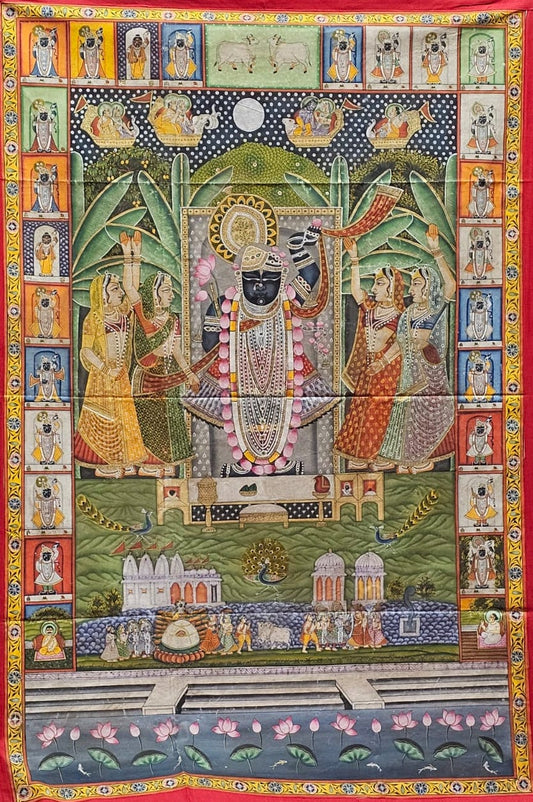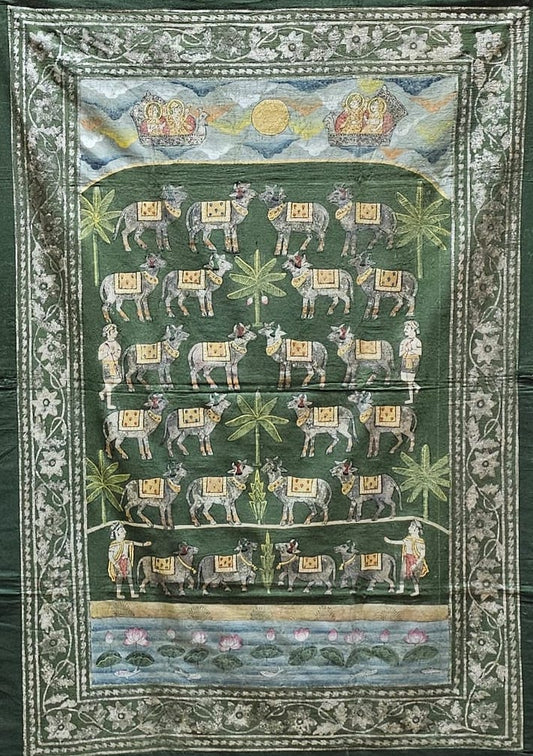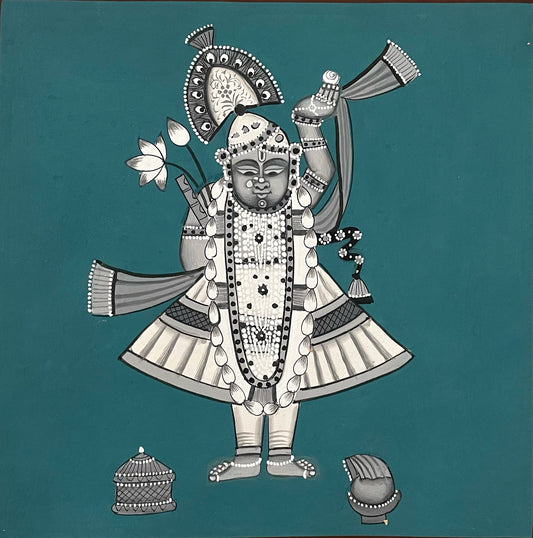All you need to know about Pichwai Paintings
History
Developed over 400 years ago (17th century) in a small town near Udaipur, Rajasthan; Nathdwara, Pichwai is traditional Indian art. Chippa artists, with expertise in designing textiles, traditionally produced Pichwai paintings, to recreate the incidents from Shrinathji’s life. According to Hindu mythology, Shrinathji is Lord Krishna’s incarnation (“swarup”) at the age of seven. The word “Pichwai” is derived from combining two different words; “pichh” which means back and “wai” means cloth hanging. Thus, Pichwai means cloth hanging at the back, which is how traditionally Pichwai paintings were used, hung behind Shrinathji’s idol in temples.
Originally, Pichwai was exclusively used to decorate the walls of Shrinathji’s temples at Nathdwara and used to portray and celebrate the different incidents and festivals in Krishna’s life. Over the years, Pichwai paintings became popular beyond the temples and also found place in personal and commercial collections driven by admirers and devotees, who wanted a little piece of Krishna’s life in their homes.
Significance
Pichwai paintings are significant due to the detailed artistry, the intricate techniques and the popular subject of Srinathji. It is one of the artforms that has held its popularity over the years and still finds a dedicated base of artists and patrons alike even after 400 years.
Owing to the extremely detailed and intricate artwork, it often takes months to complete a single piece of artwork by a group of artists. The artists need immense prowess and tenacity to paint the gorgeous paintings of Shrinathji, making this one of the most collectible traditional art forms of India.
Conventionally Pichwai paintings are painted by a group of artists instead of a single artist. Hence, it is difficult to find a signed Pichwai painting. However, in recent years, few professional artists have started recreating these traditional paintings of Shrinathji, who also sign them, adding to the value of the works.
Unique Features
Apart from the delicate work the artists have to pay attention to the details such as the expressions and articulation that Krishna and the Gopis carry on their faces, along with their friends and animals. Though these paintings are depictions of Krishna when He was seven years old, His other companions such as Radhika, other “gopikas” (the milkmaids), Krishna’s friends, the cowherd's men, and the plants and animals such as lotuses, Peepul trees, cows and peacocks form an important part of these exquisite paintings.
Exploring Themes and Subjects in Pichwai Art at Eikowa
Pichwai is centered on Srinathji’s life and the key themes capture various slices of it. Some of the most prominent themes include:
-
Janmashtami: This is one of the most prominent themes in Pichwai paintings, depicting the birth of Krishna. Typical illustrations include festivity scenes where the people of Vrindavan (Krishna's birthplace) are celebrating the birth of Kanha (child Krishna). Other popular imagery includes the child Krishna in the loving embrace of his parents.
-
Krishna and Gopis: In this prominent theme, young Krishna is surrounded by Gopis typically playing a flute and engaging everybody with his melodious music. Some of these themes can be fairly detailed with surroundings that encompass hills, gardens, rivers, temples and cows in addition to a detailed render of Krishna is full regalia.
-
Cows: Krishna was the protector of cows (“Gopal”) – this is reflected in cows being not just a decorative motif but also a subject in Pichwai paintings. Typical imagery includes herd of cows, Krishna playing with cows, or a herd of cows with Krishna's handprints on them.
-
Eight Darshanas: Srinathji’s devotees were looking for any and every opportunity to play with Srinathji. Yashoda (Krishna’s mother) was worried that this left no time for Srinathji for her, so she created the concept of eight darshans (sighting time) during the day, when devotees could meet Srinathji. The imagery in paintings of this theme have detailed, elaborate depiction of Srinathji in the center with select motifs indicating the 8 different darshans.
Discover the Best Pichwai Paintings of Rajasthan Online At Eikowa
-
At Eikowa, we work with some of the most accomplished Pichwai artists from Rajasthan. Our artists have been recognized nationally and internationally for their craft. We have a broad collection from which art connoisseurs can choose the imagery of Srinathji that appeals the most to you and works best for your spaces, either homes or offices. All the paintings are handmade, created on canvas, and are one-of-a-kind. The colors used are all natural colors, same as that used traditionally. Our online collection covers the entire spectrum of themes prevalent in Pichwai – ranging from Janmashtmi, to Eight Darshans to Cows.
Why are Indian Pichwai paintings popular?
Indian Pichwai paintings are popular due to the detailed craftsmanship involved in creating them, and the associated heritage. The stories told through Pichwai paintings are some of the most popular lores of Krishna (Srinathji), and symbolize the compassion, and community living that he embodied. Given Krishna is one of the most popular deities in India, as well as internationally, Pichwai paintings have made their way to homes and offices of devotees, art connoisseurs and celebrities. In fact, one of the most popular tennis players of recent times, Novak Djokovic, is a Krishna bhakta and owns a Pichwai painting. This is an example of the immense popularity and faith in Krishna across the globe and by extension, explains the popularity of this artform, that finds its essence in Krishna.
Techniques and Materials for Crafting Pichwai Paintings at Eikowa
https://www.cottage9.com/art-technique/art-of-pichwai-painting/)
We work with the native artists of Rajasthan, whose families have been traditionally, working on Pichwai art. Pichwai art uses natural colors and hence, these artists create the colors from fruits, vegetables and leaves. There are many signature techniques, like embossing highlights with gold/ silver leaves that are employed in creating the artwork. Similarly, high-quality, natural canvas is used which ensures lasting of the artwork and retains the lustre of the natural colors.
What is the process of making Pichwai Paintings?
The art of making a Pichwai painting consists of six major steps:
-
Making the colors: Pichwai paintings are traditionally made from natural colors. One of the first steps is to create colors of the right hues from leaves, vegetables and flowers, that would make the paintings stand out.
-
Preparing the Canvas: Similarly, the right canvas that works well with the colors is prepared. Historically, khadi was used as the canvas and in recent times, cotton and silk canvases have been used.
-
Making initial sketch: The artists start with creating a first draft of the imagery that they want to create. Pichwai paintings are highly symmetrical in most cases, and this step ensures that the composition is precise and balanced. In addition to sketching the major subjects, the key details like the eyes, nose, the overall body are also sketched such that there is no unintended asymmetry.
-
Colouring: Next, sketch is colored using natural colors. This process is highly elaborate as even within the sketch, multiple details are directly brought through colors. The coloring is done with fine brushes made of goat or horse hair for maximum control in coloring.
-
Adding embellishments: Post the coloring, gold and silver leaves are set into the paintings for highlighting specific elements. The metal is crushed into thin sheet, shaped into the intended highlight, and then affixed with thread to the canvas to create unique contours.
-
Framing: Optionally, as a last step, the painting is framed on wood often with a glass mirror.
How to Restore and Clean Pichwai Paintings
-
Pichwai Painting Maintenance and Cleaning
Pichwai paintings are easy to maintain and require just a few nuances to be kept in mind for ensuring that they remain clean. Some of the best practices include:
-
Handling the canvas with clean hands, ensuring there is no oil or grease on hands
-
Ensuring that the painting is not exposed to smoke, pollution emissions, direct harsh sunlight, and excessive humidity (from walls)
-
Using a sturdy wooden frame for the right support
-
Using soft, dry and clean brushes for cleaning once in a while
-
Pichwai Painting Restoration
-
Identification of issues like flaking, cracks or discolouration
-
Removing dirt through soft solvents
-
Retouching areas where color is missing/ painting has flaked/ cracked
-
Applying a varnish after drying of the painting to ensure preservation
-
Restoration for Pichwai paintings should be done only with the help of a professional restorer
-
Typical process steps involved are:
Why Should You Choose Eikowa to Buy Pichwai Paintings Online?
-
Working with accomplished artists: Eikowa works with the most esteemed Pichwai artists, who have been practicing this craft since decades
-
Wide variety: Our artwork collection spans across all major themes seen in Pichwai paintings
-
Signature décor pieces: We have curated the artwork such that you can have these as signature pieces in your homes
-
Certificate of authenticity: We provide tamper-proof certificate of authenticity that the Pichwai paintings bought from Eikowa are original
-
(Ref link: https://artociti.com/collections/pichwai-collection?page=2)
Frequently Asked Questions
Question: How are the Pichwai paintings at Eikowa different from those found in other websites?
Answer: At Eikowa, we have a curated collection working with the most experienced Pichwai artists from Rajasthan. Our collection carries the finest paintings amongst Pichwai paintings as these artists have been domestically and internationally recognized. Our collection has the most detailed paintings with the highest degree of finesse.
Question: How do I know that these paintings are original?
Answer: At Eikowa, we provide a tamper-proof certificate of authenticity certifying that the Pichwai paintings purchased from us are original.
Question: Do Pichwai Paintings make for good décor pieces?
Answer: Pichwai paintings make a great addition to your home and can serve as a signature piece. These fit in well in both traditional and modern setting, as they bring in an aura of exquisiteness and a texture marked by details. Additionally, given multiple themes available, one can choose the paintings that best suit the aesthetics of your interiors.
Question: How do I purchase Pichwai paintings?
Answer: To purchase a painting that you like, you can simply select it and then follow the process as in any ecommerce platform to purchase the art online.
Question: How much time do you take to ship?
Answer: We ship the paintings within 5-7 days of purchase domestically, and around 10-12 days internationally.

















